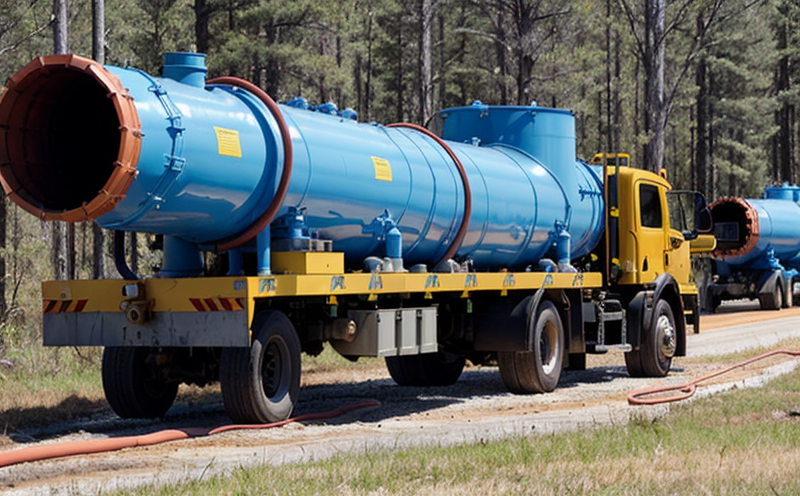ASTM G42 Cathodic Protection Testing for Pipeline Steels
The ASTM G42 standard provides a method to determine whether cathodic protection is effective on pipeline steels. This testing ensures the integrity of pipelines, reducing the risk of corrosion and associated safety hazards.
Understanding the principles behind this test requires an overview of how cathodic protection works. Cathodic protection involves applying an electrical current that polarizes a metal structure to prevent it from corroding by shifting its potential toward more noble regions. For pipeline steels, this means maintaining a negative potential relative to the surrounding soil.
The ASTM G42 test specifically evaluates the effectiveness of cathodic protection systems on pipeline steels using a combination of half-cell potentials and current measurements. The test involves placing reference electrodes at various points along the pipeline and measuring the potential difference between each electrode and the pipeline steel. This allows for a comprehensive assessment of the coverage and uniformity of the protective current.
Specimen preparation is crucial in ASTM G42 testing. The pipeline sections to be tested are typically selected based on their location, age, and history of protection. Prior to testing, these sections undergo thorough cleaning and inspection to ensure that any existing corrosion products or loose materials do not interfere with the test results.
The instrumentation used in ASTM G42 testing includes a variety of devices designed to measure potential differences accurately. These include high-precision digital voltmeters and data loggers capable of recording multiple points along the pipeline simultaneously. The use of these instruments ensures precise, reproducible measurements that are essential for accurate interpretation of the test results.
The testing process involves several steps. Initially, reference electrodes are installed at predetermined intervals along the pipeline. These electrodes serve as a point of comparison against which the potential of the pipeline steel is measured. Once in place, a series of half-cell measurements are taken to establish a baseline for cathodic protection effectiveness.
Following the initial measurement phase, current is applied to the pipeline to initiate or enhance cathodic protection. The test then proceeds with continuous monitoring of potential differences between the reference electrodes and the pipeline steel. This monitoring continues over an extended period, typically several days, to ensure that any changes in the protective current are captured.
During this time, data is recorded continuously and analyzed for patterns or anomalies. Key parameters such as polarization resistance and uniformity of potential distribution are calculated from the collected data. These metrics provide insights into the effectiveness of the cathodic protection system and highlight areas that may require attention or adjustment.
The results of ASTM G42 testing are typically presented in a comprehensive report detailing the test setup, measurements taken, and analysis performed. This report serves as a critical tool for quality managers and compliance officers to assess the current state of cathodic protection on pipelines and plan necessary maintenance or corrective actions.
Benefits
The primary benefit of ASTM G42 testing lies in its ability to ensure the long-term integrity of pipeline systems. By providing a detailed assessment of cathodic protection effectiveness, this test helps prevent costly repairs and replacements due to corrosion damage.
From an operational standpoint, maintaining effective cathodic protection reduces downtime associated with pipeline shutdowns for maintenance activities. This not only enhances overall efficiency but also minimizes disruptions to critical infrastructure.
Cathodic protection is essential for the safety of personnel and the environment around pipelines. By preventing corrosion, this test helps eliminate potential hazards such as leaks or ruptures that could lead to environmental contamination or personal injury. The ASTM G42 standard thus plays a vital role in upholding safety standards and regulatory compliance.
In terms of sustainability, effective cathodic protection contributes to resource conservation by extending the useful life of pipelines. This reduces the need for frequent replacements, thereby minimizing waste generation and associated environmental impacts.
International Acceptance and Recognition
The ASTM G42 standard is widely recognized and accepted across various countries and regions due to its rigorous methodology and consistent results. Many international standards organizations, including ISO and EN, have adapted or referenced the principles of ASTM G42 in their own guidelines for cathodic protection testing.
In Europe, the European Committee for Standardization (CEN) has adopted ASTM G42 as a basis for its own pipeline corrosion protection standards. Similarly, organizations such as the American Petroleum Institute (API) and the International Organization for Standardization (ISO) have incorporated aspects of this standard into their specifications.
The global acceptance of ASTM G42 is further bolstered by its use in regulatory frameworks governing the oil and gas industries worldwide. Regulatory bodies like the United States Department of Transportation (USDOT) and various national energy agencies recommend or mandate the application of ASTM G42 for ensuring pipeline safety and compliance.
The widespread adoption of this standard reflects its importance in the global industry, making it a cornerstone for quality assurance and regulatory compliance in natural gas distribution and pipeline operations.
Environmental and Sustainability Contributions
ASTM G42 testing significantly contributes to environmental sustainability by minimizing the risk of pipeline leaks and ruptures. These incidents can lead to significant environmental damage, including soil contamination, water pollution, and habitat disruption.
By ensuring that cathodic protection systems are effective, ASTM G42 helps prevent such accidents, thereby protecting ecosystems and biodiversity along pipeline routes. This not only aligns with broader sustainability goals but also supports the principles of responsible resource management.
The reduction in environmental impact associated with effective cathodic protection extends to energy conservation as well. By extending the lifespan of pipelines, this test helps optimize the use of natural gas resources, ensuring that they are utilized efficiently and sustainably.
In addition to direct environmental benefits, ASTM G42 testing also supports broader sustainability initiatives by promoting best practices in infrastructure management. This includes fostering a culture of continuous improvement and innovation within organizations responsible for pipeline operations.





